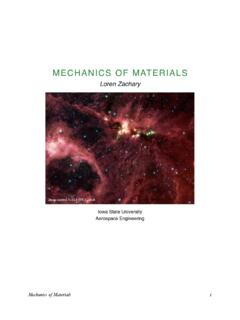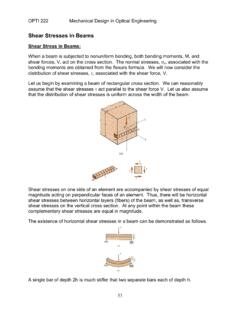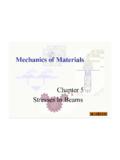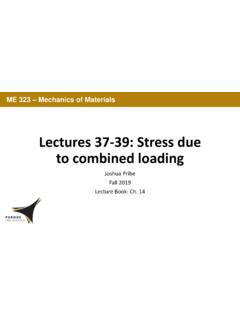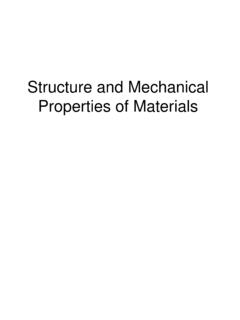Transcription of Stresses due to axial force - Iowa State University
1 MECHANICS OF MATERIALSL oren ZacharyIowa State UniversityAerospace Engineering Mechanics of Materials!1 TABLE OF CONTENTSU niaxial Forces and Stresses !3 Illustration of Stress Distribution!5 Example 1!6 Failure at Minimum Cross-Section!8 Failure Due to Contact force : Bearing Stress!10 Mechanics of Materials!2 MECHANICS OF MATERIALSL oren ZacharyIowa State UniversityUniaxial Forces and StressesThe most fundamental of all loading conditions is of two co-linear forces applied to a straight rod or beam. A beam is a structural member that can resist bending whereas a rope has little bending resistance. The rope below is pulled on and resisted by the force P.
2 P is referred to as an axial force . Only two forces are required to keep the rope in equilibrium. The two forces in the Free Body Diagram, FBD, are collinear. A FBD of a member with two frictionless pins is used to prove that only two equal and opposite forces are required to satisfy : A two force member has no moment applied at any location on the member, otherwise the two horizontal forces would not be two horizontal forces are zero leaving only the two equal forces Ay and By. The forces are collinear.
3 Mechanics of Materials!3 Fy = 0 = Ay - By Ay = -By Fx = 0 = Ax + Bx Ax = -Bx MA = 0 = L Bx Ax = -Bx = 0 YBBAXYALPPPTOOLBOX: As one of the tools in your toolbox, the inspection of a structure for two force members is an important the photograph below two members of a front end loader are identified as two force members. The line of action of the loads passes through the pins and centroids of all cross sections. Since the vertical member is straight the load P passes through the centroids of the cross-sectional area at any position along the length of the member. This is a condition necessary to eliminate bending.
4 The member will only force P acts on a typical cross-section shown on the action P acting on the cross-sectional area needs to be characterized. The following observations are important. The material is not stressed as much at locations where the cross-sectional area is large. Small cross-sections are more likely to fail than larger sections. It is assumed that the cross section reacts uniformly to P. To account for the area variation, P is divided by the area A; there will be more about this later. P/A is stress and has units of force /area. The strict assumption is that the member is straight and the cross-sectional area is constant along the length.
5 This assumption is relaxed in practical situations where the change in cross-section is gradual. Large tapers will not have a uniform stress distribution within the cross-section. The member above has a small taper. The internal force passes through the centroid of the cross-section. This is done to separate Stresses due to axial loads from bending of Materials!4 Cross-sectionPPPPILLUSTRATION OF STRESS DISTRIBUTIONThe force P is evenly spread over the cross-sectional area wt. The intensity of the force is the stress and is defined as force divided by the stress is normal, meaning perpendicular, to the cross-sectional area and is often designated as a normal stress.
6 Typical units are:ENGLISHENGLISHSISIlb/in2psiN/m2Pa100 0 psiksi1000 PakPa(106) psiMsi106 PaMPa109 PaGPatwCross-sectional Area= wtUniform Stress(Pressure)PPMechanics of Materials!5 =PA=PwtEXAMPLE 1I-beams such as the one represented below are commonly used in bridges and buildings. The axial load acting through the centroid of the cross-section causes the same type of stress as calculated by equation above. An I-beam has a cross-sectional area of 5 in2 and is subjected to a load of 20,000 lb [also referred to as 20 kip load where kip = 1000 lb]. What is the normal stress? Similarly 20,000 lb is also written as 20 of Materials!
7 6 =PA=20,000lb5in2=4000psi =PA=20kip5in2=4ksiEXAMPLE 2A C-channel must be used to support a load of 100 kN. The stress cannot exceed 150 MPa. What is the mini-mum area required to support the load? Notes: The area is the same regardless of the shape (pipe, I-beam, rectangular, box beam, angle, etc.) . This is the minimum area required to satisfy the stated conditions. The uniaxial load must be applied through the centroid of the cross-section. The applied load is distributed to the channel through end plates. The load can then be applied at the centroid of the CapLL100 kNCentroidElevation View[side view]Mechanics of Materials!
8 7A=P =100(10)3N150(10)6N/m2= (10) 3m2=667mm2 =PAFAILURE AT MINIMUM CROSS-SECTIONThe double lap joint at the right will be used to illustrate the identification of Stresses at possible failure sites. A pin (bolt) is used to carry the load from the two outer plates to the middle plate. PPLooking at the top and bottom plates, the reduced area of the plate at the pin (bolt) location can be a location of failure. A FBD is drawn that shows the possible failure surface. Comments on the how the pin loads the hole: The pin pushes on the front portion of the hole. The portion of the hole shown is not loaded, thus the failure surface supports all of the force of P/2 acts on an area of thus,Dh(h-D)/2(h-D)/2bPMechanics of Materials!
9 82PP/2P/2 =P(h d)bA=h d2b =PA=P2h d2bPPA second way of looking at the problem is to realize that the load P is being carried by all of the shaded failure surface with an area ofgiving the same answer as third way of looking at this problem is to use the FBD of the right portion of the plate. The same areas and forces are encountered in this case as in the other two approaches. Dh(h-D)/2(h-D)/2bP/2P/2 PIt is imperative that a FBD be drawn that cuts through the candidate failure surfaces. The areas and the forces acting on the surfaces are used to calculate the of Materials!9A=(h d)b =PA=P(h d)bA=(h D)b =P(h D)bFAILURE DUE TO CONTACT force : BEARING STRESSThe pin is pushing on the half arc.
10 The pressure (stress) distribution is not uniformly distributed on the half arc surface. The distribution is dependent on the fit of the pin in the hole. A loose fit means that the stress will be larger because there will be less contact area. The Stresses are also dependent on the ma-terials used for the pin and plate. The area in front of the pin can be permanently deformed and material bulges out of the practical approach has historically been taken to characterize this type of problem. The bearing stress is calculated using the bearing area that is a rectangular patch size D by b. It is assumed that the bear-ing Stresses are uniformly distributed over this area.
